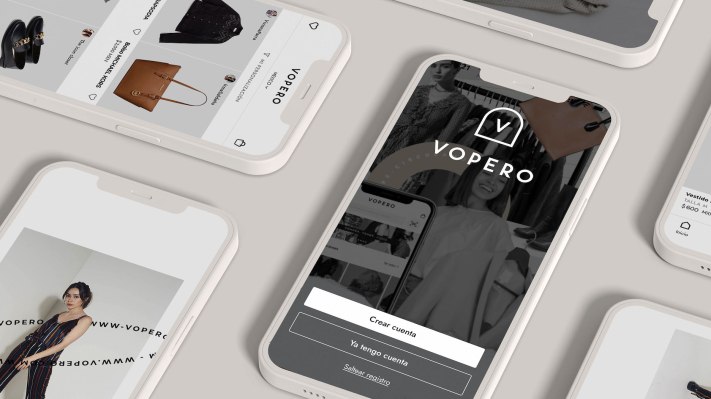The second-hand retail market has a spotlight on it amid increased consumer comfort in purchasing previously used items in recent years and the fact that the fashion industry accounts for a lot of waste in landfills. As such, reports forecast that the global resale market, also known as recommerce, is poised to reach about $350 billion by 2027.
However, it’s still not the easiest thing to locate second-hand items, especially in Latin America. Some startups find this area ripe to inject technology into the commerce chain so that retailers can more easily accept products for sale and facilitate the movement of items to new homes.
Devolut and Reversso are helping out on the returns side in the region, while Uruguay-based Vopero is working on resale. The company’s name means “their virtual closet” in Spanish, and it was founded in 2020 to introduce a new generation of consumers in Latin America to choose second-hand first, Vopero co-founder and CEO Alejandro Esperanza told TechCrunch.
Esperanza and co-founders Maggie Ferber and Ignacio Cattivelli are going after Latin America’s $40 billion resale market. They label what they’re doing “resale-as-a-service,” and developed an end-to-end solution.
Its proprietary technology combines the ability to process a large number of products with a full-service resale fashion marketplace. Simply put, Vopero does all the work for sellers, who can leverage an omnichannel approach to marketing their available goods. It also provides personalized online buying and selling experiences as well as demand and sales analytics.
Here’s how it works: Sellers download the Vopero app and request a Vopero kit that includes a bag with a QR code that will hold about 30 garments. Once filled, the seller scans the QR code to schedule a pickup from their home. Similar to how ThredUP, Poshmark and The RealReal operate, Vopero processes the garments and uploads images to the platform where sellers can monitor the sales process.
Currently it can take up to a week for garments to be posted on the platform, however, Ferber said in an interview that the company tells sellers it could take up to three weeks. Items average 15 days to sell on the site, Esperanza said.
Sellers receive notifications when something sells and can transfer the earnings to a bank, donate them to local foundations or make purchases on the platform. If certain garments are not selected for resale, sellers are provided with the reason and said garments are donated for direct impact, upcycling or recycling.
Meanwhile, buyers can use Vopero online or via an iOS or Android app to then find second-hand clothing and accessories from popular brands, including Zara and Prada. Users can search by terms like brand, size and color.
The safety of those using Vopero is also top-of-mind for the co-founders.
“Consumers are looking for a solution for their closets,” Ferber told TechCrunch. “In that sense, what we built attends to the needs of the security and safety needed for us dealing with it all, especially the payments. That way, there is some trustworthiness attached to the brand as we sit in the middle between buyers and sellers.”

Vopero co-founders, from left, Ignacio Cattivelli, Maggie Ferber and Alejandro Esperanza. Image credits: Vopero
At its core, the company operates as a consignment store and makes money when items sell. The average take rate is 60%, however, that also depends on the kind of item being sold, Ferber said. For example, if it was initially an expensive handbag, Vopero’s take will be lower.
Vopero currently operates in Uruguay and Mexico. The company has a large base of recurring customers, mainly through the app, Esperanza said. There were close to 400,000 downloads in the past year. Meanwhile, the company processed over 1 million unique garments last year, while annual sales exceed $5 million. The company is also on a direct path to profitability.
That growth attracted new venture capital funding, with the company recently closing on $4 million in funding. Cencosud Ventures led the round and was joined by existing investor Grupo Axo. To date, Vopero has raised $10 million in venture-backed funding.
The co-founders say the capital will go into three buckets:
- Growth — Vopero intends to launch in Chile by the end of the year. The goal is to put 1,000 of its items in “corners” of physical retailers and expects to have 40 such corners in Paris stores (owned by Cencosud) in the next 18 months. Each corner will have a QR code where shoppers can go online and view thousands of additional clothing options.
- Franchising — speaking of physical stores, the company wants to continue that trend by accelerating its franchising program in physical department stores, including at least 20 franchises in Mexico by the end of the year. Vopero already has some of its resale items in two stores in Mexico and one in Uruguay. All stores have positive EBITDA already, Ferber said.
- Awareness — Vopero plans to increase adoption of resale practices among the top fashion brands. It is also utilizing influencers, over 450 of them now, who are showing their closets on the app.
“We want to be perceived as an option that goes in the same way as accessible fashion, but with a sustainable approach,” Esperanza said. “We want to gain not only our generation that targets each other to purchase these kinds of platforms, but for them to understand the impact of fashion, and how they can change the world through fashion.”
